Plus Two Physics Chapter Wise Previous Questions Chapter 2 Electric Potential and Capacitance is part of Kerala Plus Two Physics Chapter Wise Previous Questions and Answers Kerala. Here we have given Plus Two Physics Chapter Wise Questions and Answers Chapter 2 Electric Potential and Capacitance.
Kerala Plus Two Physics Chapter Wise Previous Questions and Answers Chapter 2 Electric Potential and Capacitance
Question 1
Two hollow conductors are charged positively. The smaller is at 50V and the bigger is at 100V potential. (March – 2009)
a) What will happen if these conductors are connected externally as shown (Picture 1)?

b) What will happen if these conductors are connected as shown below (Picture 2)? Why?

Answer:
a) Here positive changes flows from bigger conductor (higher potential) to lower one (lower potential)
b) Now charges flow from the inner conductor to the outer conductor. This is because charges have a tendency to resides on the outer surface of the hollow conductor.
Question 2.
One coulomb change is initially at nest and is accelerated thnough a potential difference of 1 volt. During this process the kinetic energy acquired by the change is (March – 2010)
a) I J
b) 1.6 x 10-19 J
c) 1.6 x 1019 J
d) 10 J
Answer:
a) KE – eV
= 1 x 1 = 1J
Question 3.
Capacitors are considered to be the building blocks of all integrated circuits. A parallel plate capacitor is a simple form of a capacitor. (March – 2010)
a) Write down the expression for the capacity of a parallel plate air capacitor in terms of plate area and their separation.
b) Raju found that capacity of a parallel plate air capacitor is 10mF. Find the capacity of it when he immersed the unit completely in a medium of dielectric constatn 2.5.
c) Obtain an expression forthe energy stored in a capacitor.
d) Raju charged this capacitor and he plotted a graph between charging potential and charge stored in the capacitor. The graph is shown in the figure.
What does the area of the shaded portion of the graph represent?

Answer:
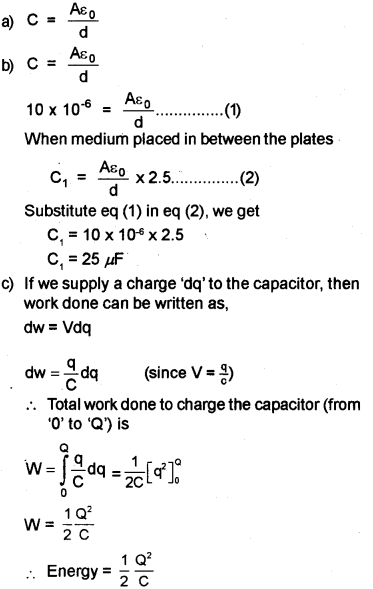
d) Area of this graph gives energy stored in the capacitor.
Question 4.
For a parallel plate capacitor with each plate of area ‘A’ separated by distance ‘d’ in air, its capacitance is given by (Say – 2010)
\(\mathrm{C}=\frac{\varepsilon_{0} \mathrm{~A}}{\mathrm{~d}}\)
a) Represent the charge ‘q’ given to a capacitor of capacitance C with a potential difference ‘V’ in a graph. What will be the shape of the curve?
b) If you connect the plates of a parallel plate capacitor by a copper wire, what happens to the capacitor? Justify your answer.
c) Using the above expression, show that energy density of a parallel plate capacitor is \(\frac{1}{2} \varepsilon_{0} E^{2}\) where ‘E’ is the electric field between parallel plates.
Answer:
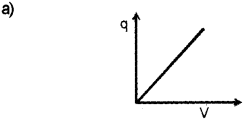
The shape of graph is a straight line.
b) Charge will be discharged by producing spark and sound.
When we connect two plates, a positive charge will move from higher potential to lower potential. This flow of charge causes spark and sound.
c) Energy stored in the capacitor

Question 5.
A capacitor is a device used for storing charge as well as energy. it is based on a property called capacitance. (March – 2011)
a) Write the SI unit of capacitance and define it.
b) You are given two capacitors of 2 mF and 3 mF. What are the maximum and minimum values of capacitance that can be obtained by combining them?
c) Obtain an expression for the electrostatic energy stored in a capacitor.
Answer:
a) Farad, We get maximum capacitance when it is connected parallel.

b) We get minimum capacitance when it IS connected in series.

![]()
c) If we supply a charge ‘dq’ to the capacitor, then work done can be written as,
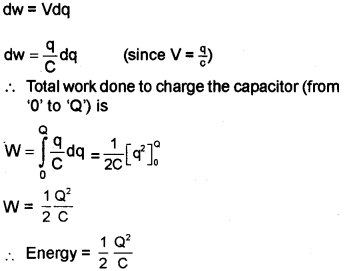
Question 6.
A capacitor is a system of two conductors separated by an insulator. (Say – 2011)
a) Write down the relation for the capacity of a parallel plate capacitor.
b) The plates of a parallel plate capacitor have an area of 90cm2 each and are separated by 2.5mm. What would be its capacity?
\(\varepsilon_{0}=8.85 \times 10^{-12} \mathrm{C}^{2} \mathrm{~N}^{-1} \mathrm{~m}^{-2}\)
Answer:
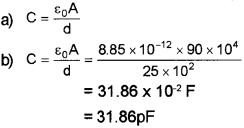
Question 7.
Besides its use in storing charge, a capacitor Is a key element of most a.c. circuits. (March – 2012)
a) What are the factors on which the capacitance of a parallel plate air capacitor depends?
b) Define the terni ‘dielectric constant’ of a medium.
c) Two capacitors C1 and C2 are connected in se ries. Derive an expression for the capacitance of the combination.
Answer:
a) Area of plates, seperation between two plates and the medium which is placed in between the plates.
b) The ratio of the electrostatic force of interaction between two given point charges held certain distance apart in vacuum to the force of interaction between the same two charges held the same distance apart in the material medium.
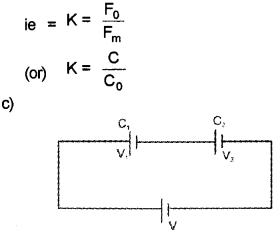
Let two capacitors C1 and C2 be connected in series to p.d of y. Let y1 and y2 be the voltage across C1 and C2.
The applied voltage can be written as

Question 8.
a) The electrostatic force between two charges is governed by Coulomb’s law. On which factors does the electrostatic force between two charges depend and how? (Say – 2012)
b) If the air medium between the two charges is replaced by water what change you expect in the electrostatic force and why?
c) An electric dipole is palced in an external electric field. Obtain an expression for the potential energy of the dipole.
Answer:
a) According to columb’s law the electrostatic force between two charges,
\(F=\frac{1}{4 \pi \varepsilon_{0} k} \frac{q_{1} q_{2}}{r^{2}}\)
The force between two charges depends on
- Magnitude of charges
- Distance between charges
- medium filled in between charges.
b) The relative dielectric constant of water is 81. Hence the force between two charges is reduced by \(\frac{1}{81}\)
c) Consider a dipole of dipole moment ‘P’ suspended in a uniform electric field of intensity ‘E’.
Then we know torque τ = PE sinθ
Let the dipole be turned through an angle d9 then work done dw = τ dθ = PE sinθ dθ
Total work done ip rotating the dipole from \(\theta_{1} \text { to } \theta_{2}\)
\(\begin{array}{l}
\mathrm{W}=\int_{\theta_{1}}^{\theta_{2}} \mathrm{PE} \sin \theta \mathrm{d} \theta \\
\mathrm{W}=\mathrm{PE}\left(\cos \theta_{1}-\cos \theta_{2}\right)
\end{array}\)
This work done is stored as potential energy.
Question 9.
The region around a charge where its effect can be felt is called the electric field, (March – 2013)
a) The electric field lines corresponding to an electric field is shown below.

The figure suggests that

b) Some equipotential surfaces are shown in the figure. What can you say about the direction of the electric field.
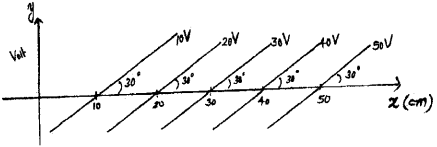
Answer:
a) EA = EC > EB
Density electric field is same at A and C: Hence EA = EC. Density of the electric field is smaller at B than A.
Hence EA > EB
b) Direction of electric field is always perpendicular to equipotential surface.
Question 10.
A parallel plate capacitor consists of two metallic plates separated by a small distance with a dielectric in between. (Say – 2013)
a) A parallel plate air capacitor has charge densities +σ and -σ on the plates. Write the expression for electric field between the plates. What happens to the field if the separation between the plates is doubled?
b) You are given two capacitors. They can be used Individually, in series or in parallel in a circuit. Let the four possible values of capacitances be 3μF, 4μF, 12μF and 16μF. If so what are the val ues of individual capacitances given to you?
c) Obtain the expression for effective capacitance, when three capacitors C1, C2 and C3 are con nected in senes.
d) A parallel plate capacitor with air between the plates has a capacitance of 8μF. What will be the capacitance if the distance between the plates is reduced by half and the space between is filled with a medium of dielectric constant 5?
Answer:
a) \(E=\frac{\sigma}{\varepsilon_{0}}\)
No change in elecinc field if plates are seperated.
b) The four possible values of capacitances are 3μF, 4μF and 16μF We get maximum capacitance in
¡e, 16C1 + C2 …………….(1)
Similarly, we get minimum capacitance in senes.
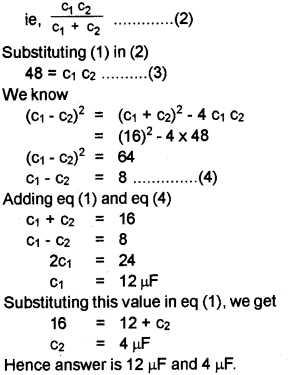
c) Capacitors in senes Let three capacitors C1, C2 and C3 be connected in series to p.d of V. Let V1, V2, and V3 be the voltage across C1, C2 and C3.
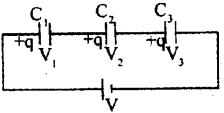
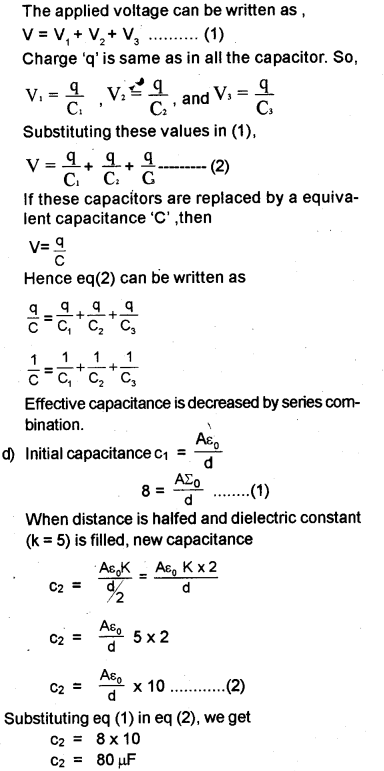
Question 11.
‘Gauss’s law is true for any dosed surface, no matter what its shape or size” say the following statements are true or false. (March – 2014)
a) Gauss’s law implies that the total electric flux through a closed surface is zero if no charge Is enclosed by the surfaóe.
b) This law is useful for the calculation of the electrostatic field when the system doesn’t possess any symmetry.
c) In a uniform electric field, we know that the dipole experiences no net force; but experiences a torque having a relation with P and E is given by…………….. where the parameters P and E have their usual meaning.
Answer:
a) True
b) False
c) \(\vec{\tau}=\overrightarrow{\mathrm{P}} \times \overrightarrow{\mathrm{E}}\)
Question 12.
There is a flow of current between two changed bodies when they connect together
a) An electric charge produces
i) Electric field only
ii) Magnetic field only
iii) Both electric and magnetic fields.
b) Electromotive force represents
i) force
ii) energy
iii) energy/unit change
iv) current
Answer:
a) Charge at rest produces an only electric field,
b) Energy/unit charge
Question 13.
A parallel plate capacitor connected to a cell gets fully changed. After disconnecting the cell a thin sheet of mica is placed between the plates of the capacitor. What happens to its
a) Charge
b) Capacitance
Answer:
a) Charge remains constant
b) Capacitance increase
Question 14.
a) A device to store electrical charge is called (March – 2015)
a) Transformer
b) Capacitor
c) Resistor
d) Inductor
b) What is meant by the energy density of a parallel plate capacitor?
c) Derive an expression for the energy stored in a parallel plate capacitor.
d) What is the area of the plates of a 0.1 μF parallel plate air capacitor, given that the separation between the plates is 0.1 mm.
Answer:
a) Capacitor
b) Energy stored per unit volume of a capacitor is called energy density. Energy density \(\mathrm{V}=1 / 2 \varepsilon_{0} \mathrm{E}^{2}\)
c) Derive an expression for the energy stored in the arrangement.
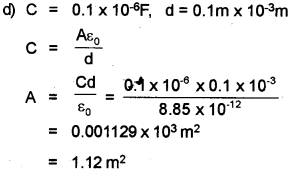
Question 15.
An equipotential surface is a surface with a constant value of the potential at all points on the surface. (March – 2016)
a) What is the amount of work done in moving a 2μC charge between two points at 3 cm apart of an equipotential surface?
b) Two capacitors are connected as shown in the figure below

If the equivalent capacitance of the combination is AμF
i) Calculate the value of C.
ii) Calculate the charge on each capacitor
iii) What will be the potential drop across each capacitor?
c) Two metallic spheres of same radii, on hollow and one solid, are charged to the same potential. Which will hold more charge?
i) Solid sphere
ii) Both will hold same charge
iii) Hollow sphere
iv) Cannot predict
Answer:
a) zero
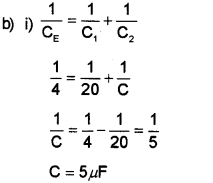
ii) Charge on each capacitor is same.
q = CV = 4 x 10-6 x 12 = 48μC
iii) Potential drop across
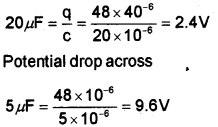
c) ii) Both will hold same charge
Question 16.
a) You are given two capacitors having capacitances C1, and C2. (Say -2016)
Derive an expression for the equivalent capacitance in
i) Series and
ii) Parallel combinations
b) The variation of charge (q) on a capacitor with voltage (V) is shown in the figure given below:
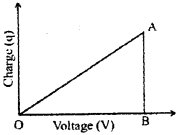
The area of the ΔOAB represents
i) Capacitance
ii) Capacitive reactance
iii) Electric field between the plates
iv) Energy stored in the capacitor
Answer:
a) (i) Refer March 2012, Q.No. 1g

Let three capacitors C1 and C2 be connected in parallel to p.d of V. Let q1 and q2 be the charges on C1 and C2.
If ‘q’ is the total charge, then ’q’ can be written as
q = q1 + q2
But q1 = C1 V, q2 = C2V
Hence eq (2) can be written as
CV = C1V+ C2V
C = C1 + C2
Effective capacitance increases in parallel connection.
b) iv) Energy stored in the capacitor
Question 17.
a) A dielectric slab is placed between the plates of a parallel plate capacitor. Its capacitance (March – 2017)
i) becomes zero
ii) remains the same
iii) decreases
iv) increases
b) Derive an expression for energy stored in a capacitor.
Answer:
a) iv) increases
b)

Question 18.
A capacitor is a device that can store electrostatic energy within the electric field set up between the plates. (Say – 2017)
a) Write an expression for the energy stored in a capacitor in terms of charge Q and capacity C.
b) The electric lines of force never intersect one another – Explain this statement.
c) Two capacitors of capacities C1 and C2 are connected in series and then in parallel. Obtain expressions for effective capacities in two cases.
OR
Obtain an expression for the capacity of a parallel plate capacitor with plate area A and plate separation d.
Answer:
a) \(\mathrm{V}=\frac{1}{2} \frac{\mathrm{Q}^{2}}{\mathrm{C}}\)
b) If two lines of force intersect, at the intersecting point, there will be two different directions for the electric field, which is not possible. Hence electric lines of force never intersect one another.
c) C1 and C2 in senes
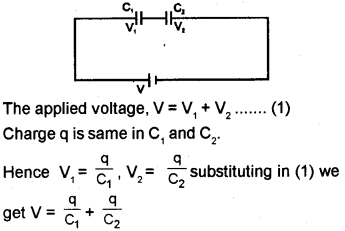

We hope the Kerala Plus Two Chemistry Chapter Wise Questions and Answers Chapter 2 Electric Potential and Capacitance help you. If you have any query regarding Kerala Plus Two Chemistry Chapter Wise Questions and Answers Chapter 2 Electric Potential and Capacitance, drop a comment below and we will get back to you at the earliest.